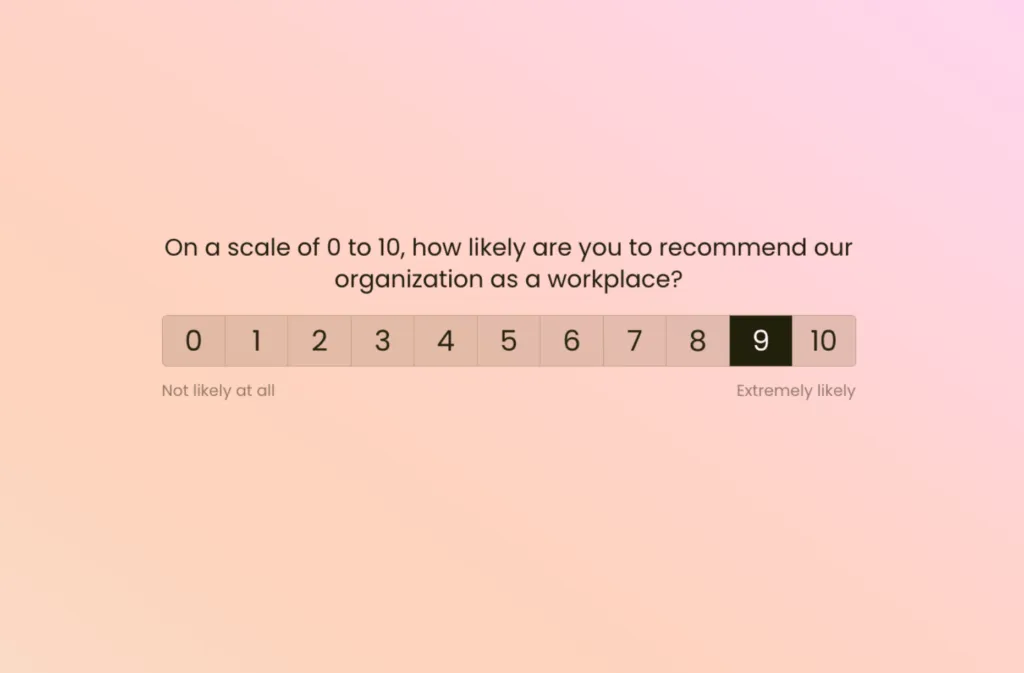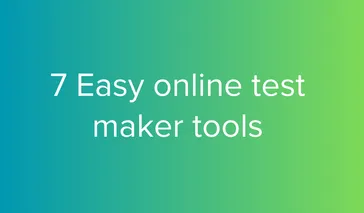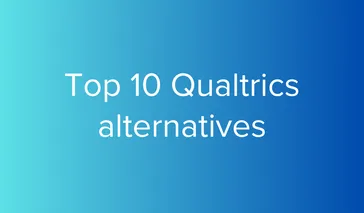8 min read
Empower employees while caring for employee well-being. Prevent employee burnout and depression.
ex Platform
Employee loyalty and engagement are crucial components of a thriving workplace. One powerful tool that organizations are increasingly leveraging to measure and enhance these aspects is the Employee Net Promoter Score (eNPS). Built on the foundation of the well-known Net Promoter Score (NPS) used for gauging customer loyalty, eNPS offers a streamlined and effective way to understand how employees feel about their workplace and their likelihood of recommending it to others.
What is Employee Net Promoter Score (eNPS)?
Employee Net Promoter Score (eNPS) is a concept built on the Net Promoter Score (NPS) to measure employee loyalty. The measurement method involves measuring the likelihood of an employee recommending their workplace to their family or friends.Imagine that you have dedicated and loyal employees in your organization. Imagine a team of employees who go out of their way to provide exceptional, amazing service to keep your customers happy and increase their satisfaction.
Employee Net Promoter Score is praised for being compact, preventing survey fatigue, easy to calculate results, and the ability to compare and repeat them at sufficient intervals because it is simple. All these features certainly put eNPS in a more efficient place.
However, if you combine eNPS with other employee surveys, you will know why employees gave negative feedback. It will uncover the reasons behind their actions and help you improve them. You can also find out if they feel motivated enough to work in the organization.
eNPS Scale - Employee Net Promoter Score and Question
Employee Net Promoter Score (eNPS) survey is based on the same concept as Net Promoter Score (NPS), originally developed by Fred Reichheld, Bain and Co. and Satmetrix in the 1990s. NPS is used to measure customer loyalty, while eNPS measures employee loyalty.
NPS is calculated based on the answers to the question:
“Would you recommend our services/product to your friends or family?”eNPS is calculated based on the answers to a similar survey question. Instead of products and services, the eNPS question helps organizations measure employee loyalty:
“On a scale of 0 to 10, how likely are you to recommend our organization as a workplace?”Similar to NPS, eNPS responses are divided into three categories:
0-6: Detractors, employees who are very dissatisfied with the organization and spread negative feedback.
7-8: Passives, employees who are not emotionally engaged or disengaged.
9-10: Promoters, employees who are extremely loyal to the organization and spread positive word of mouth.

Promoters in eNPS
A respondent is considered a promoter when they give a score of 9 or 10 to the eNPS question.It is important not to rest on your laurels if the majority of the answers are 9 or 10. It is easy to think that employees who rated your organization highly are already happy and you do not need to focus on them.
However, organizations should be focused and use the feedback from promoters and see why they like the organization and what exactly the reason they mentioned when referring your organization to their friends and family.
Neutral in Employee NPS
A respondent who scores between 7 and 8 is considered passive or neutral.Such people are called passive because it is assumed that they do not intend to promote the organization or say anything negative. They are generally happy, but since they do not directly affect the feelings of the organization, they are not given much importance.
Passive evaluators should not be ignored. Even if their score is not taken into account when calculating eNPS, do not ignore their feedback. Constantly work to turn them into promoters. Your goal should be to turn them into promoters, because they can always become detractors.
For those who answered this way, you can ask the question, “What stops you from recommending your friends or family to work for us?”
Asking questions like this creates a culture of feedback in your company, where everyone feels free to share or express their feedback.
Detractors in eNPS
A respondent is a detractor when they give answers from 0 to 6.What does this score mean? It means that the employee is very unhappy with their job at the company. Certain things bother them, and you as an employer need to get to the root cause and identify the problem.
The first step is to find out why they are not happy and why their feedback is poor. Is something bothering them? Find out what they are thinking, tell them not to be afraid and share their opinion.
Whenever you receive negative feedback from an employee, you should carefully consider their reasoning behind the response. The Employee NPS survey should clearly state that it is anonymous. This will encourage the negative employee to share their honest feedback.
High employee turnover is incredibly annoying and painfully expensive. One step in the right direction can save organizations from a bad reputation and a low eNPS score.
eNPS Benchmark - Tips
The eNPS score can depend on many factors. The value of the indicator can vary between company branches. eNPS is an indicator that needs to be constantly worked on. Having a baseline measurement, we want to increase it over time.
Very often, an organization’s eNPS can be lower than NPS because employees who work for the organization expect more from it than customers. This awareness can help organizations interpret the Employee NPS indicator.
Here are some tips on how to use eNPS effectively to get better results:
Your organization’s management should know why the survey is being sent to employees. The methods for following up on the responses should be defined in advance.
The survey will yield better results if it is responsive and accessible even via mobile devices, such as tablets or mobile phones, so that employees can quickly and easily respond to it.
In any case, the survey should be anonymous. Employees should be guaranteed that their identity is not at risk. If you, as an organization, don’t provide this assurance, the results will be less reliable and you won’t get unbiased answers from your employees.
Employee satisfaction isn’t a one-time thing. If you can’t remember the last time you asked an employee if they were happy in the workplace, now is the time to ask. Employee engagement and satisfaction are two pillars of an organization, and employers should be able to track them periodically. Experts suggest sending out these surveys quarterly, often enough that employees won’t feel nervous about filling them out.
Benefits of Employee NPS (eNPS) Survey
eNPS is very easy and fast
The most important advantage of eNPS is its ease and speed of implementation. It is hard to think of a less time-consuming way to check employee loyalty. There is no need to think about survey questions, and the result is a simple indicator.
eNPS survey is so short that everyone can complete it
Nobody likes to complete surveys. When you receive a survey that takes 15 minutes to complete, you immediately do not want to complete it. Completing an eNPS survey will take you less than a minute. That is why employees will be happy to complete it.
eNPS is an easy-to-understand indicator
The simplicity of eNPS leaves only one number. This makes it easy to understand. As an employer, you can track the progress of eNPS over time. Using a single variable leaves very little room for misunderstandings or errors.
Everyone will understand eNPS
Unlike more complex surveys, eNPS requires only a short introduction. If management has not heard of this indicator, it will not take you long to explain it.
eNPS is cost-effective
Employee Net Promoter Shore is a financially secure way to gauge employee loyalty. Since all it takes is a single email, you can measure eNPS with very little time and budget commitment.
How to improve employee Net Promoter Score (eNPS)?
Conduct Follow-Up Surveys: Enhance the standard eNPS question by including additional inquiries and follow-up surveys to explore the reasons behind employee scores. Utilize anonymous surveys to encourage honest and open feedback.
Identify Key Improvement Areas: Use eNPS feedback to pinpoint critical areas needing attention, such as recruitment, onboarding, and fostering an inclusive workplace. Prioritize actions based on feedback trends and their potential impact on employee satisfaction.
Stay Updated on HR Trends: Keep abreast of current HR trends and innovations, like flexible work options, employee wellness programs, and advanced learning and development tools, to continually improve the employee experience.
Regular eNPS Measurement: Schedule eNPS surveys at consistent intervals (e.g., quarterly or bi-annually) to track trends and evaluate the effectiveness of implemented changes. Integrate survey schedules into the company calendar to ensure regular participation and timely data analysis.
Streamline Employee Experience Management: Centralize the management of employee feedback and experience. Use a comprehensive platform that simplifies the process with intuitive tools, pre-written survey templates, and expert-crafted questions to easily create, distribute, and analyze surveys.
By integrating eNPS into your HR strategy, you can effectively retain top talent and attract new employees, making it an essential tool in today’s competitive job market. Consistently monitoring eNPS allows you to stay attuned to employee engagement, ensuring that your initiatives meet their needs and expectations.






